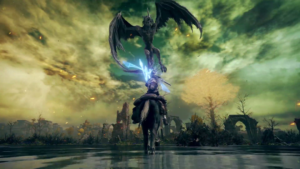The curious RPG Live A Live is a fascinating time capsule of an era when RPGs were still experimenting heavily with structures and ideas, and its long-awaited remake proves that the best, weirdest efforts of that experimentation can still shine today. Its unusual story structure of seven different vignettes ranging from prehistory to the far, spacefaring future, is immediately striking after decades of grandiose, linear RPGs. And its initial disparate story threads are upheld and pulled together by its ensemble cast of lovable characters. But what truly makes Live A Live a triumph is the way it pulls its disparate threads together to subvert expectations of JRPGs not only as they existed in 1994 when it was first made, but somehow still almost three decades later in 2022.
Most of the best things about Live A Live’s remake were present in its original form, which makes it all the more a shame it never made it to the West back in the ‘90s. That said, this remake would have been worth the effort even if we were already familiar with the story and gameplay. While the original was not the prettiest of Square’s RPGs even for its era, the HD-2D look pioneered by Octopath Traveler continues not to miss when it comes to wonderfully marrying sprite-based nostalgia with modern 3D capabilities. Live A Live is lovely, full of eye-catching color schemes and memorable snapshots where Square has used the depth of its 3D backgrounds to full effect. That could be in memorable moments like a shinobi running over rooftops against a violet twilight, or sparkling sunlight dripping into a castle throne room.
On the surface, all of Live A Live’s seven vignettes are disconnected, and it largely doesn’t matter which one you start or end with. You can even pick one up, put it down, start another, and return to the first later if it suits you; Live A Live will conveniently keep track of your progress in each story even if you save over a file, a feature I made a lot of use of as the discovery of numerous, fun hidden secrets prompted me to revisit chapters I’d thought I’d combed thoroughly.
Not only do the different chapters take place in different eras, but each one distinguishes itself with unique characters and mechanics to suit them. In prehistory, for instance, language has yet to be invented, so all the storytelling brilliantly takes place with animation and imagery. Here and only here, the protagonist caveman Pogo can use his powerful sense of smell to track down the whereabouts of NPCs or enemies he’s looking for. The Edo period shinobi Oboromaru can cloak himself in shadow to hide from enemies and complete his entire chapter without killing a single human, or he can brutally murder his way through the manor he’s infiltrating. The Sundown Kid, a Wild West gunslinger, doesn’t fight nearly as much as the others – instead, he works with the local townsfolk to lay traps for the bad posse on its way to wreak havoc. Near Future’s Akira can read minds and teleport out of battle, though his teleport ability is intentionally a bit unreliable. Though quite different from one another, Live A Live’s ensemble cast all manage to endear themselves in their respective stories; I still can’t pick a favorite.
The 2022 Live A Live remake’s characterization is further improved by the introduction of voice acting, which is present in all important story scenes. Both Japanese and English tracks are available, and while the English acting had some occasional awkwardness in chapters like Edo Japan, having voice acting at all was a net positive for an RPG so profoundly centered on building up an ensemble cast of interesting characters.
“
The unique flavors of each protagonist, era, and theme play out in battle, too. While all seven characters use the same grid system to move about the field and launch attacks at foes in turn-based combat, Live A Live manages to theme each protagonist’s moves in ways that effectively reflect their personality. Oboromaru – a ninja – uses lots of area-of-effect abilities to lay traps on the field and force enemies to either move or take damage. Sundown has a gun, so everything he does is long range. Imperial China’s Earthen Heart shifu master can pass on battle techniques to his students as he trains them, while Present Day’s Masaru Takahara learns martial arts moves from his enemies. In the Far Future, the supportive robot Cube doesn’t fight at all, except in an optional arcade game located on their spaceship. Learning the ways in which each of the seven diverse characters can take advantage of the same battle system over the course of Live A Live was one of its pleasures, and I was more than once impressed by the ways in which the marriage of combat and character either furthered the plot or told me something interesting about a character I loved.
Each chapter’s enemies are designed around the respective character’s unique abilities, and the deceptively simple grid system reveals plenty of tricks up its sleeves. The deeper I dug into each chapter, the more I was forced to reckon with the grid not just as a means to get my attacks lined up, but also as a tool for predicting enemy moves and avoiding them so my team wasn’t decimated. Some chapters have additional nuances, such as enemy weaknesses and resistances to certain types of attacks, or enemy captains that take the whole rest of the team with them when destroyed. Don’t underestimate Live A Live’s battle system, especially if you want to go after the well-hidden handful of ultrahard secret bosses scattered throughout several of its chapters.
All of Live A Live’s battle and field mechanics play beautifully in the context of each respective chapter, many of which lean gently, but not obnoxiously, into popular film, TV, and even gaming tropes. In their early hours, you might recognize the plot of Far Future from some popular science fiction films, Present Day is a clear homage to arcade fighting games, Near Future debuts with all the bombast of a mech anime, and Imperial China plays out like a stereotypical kung fu feature…until, suddenly, they don’t. While some of the vignettes are certainly stronger than others, they all manage in different ways to subvert the tropes they’re embracing. Were Live A Live merely a collection of its initial seven separate vignettes with loosely connected themes and ideas, I’d have walked away happy enough with my experience.
But, wonderfully, there’s more.
I don’t want to spoil Live A Live for those who are unaware of its biggest twists from the original ‘94 Japan release, and if you’re in that camp, I’m begging you to go in without looking anything up. What I can tell you is this: The best thing about Live A Live is the way it made me suspicious of what it was actually about, and then proved my suspicions correct before turning them on their head. As I played through these vignettes and reached their various endings, I quickly noticed a very obvious common thread between them, and expected that thread to reward me once I finished them all with something fairly obvious and RPG-like – an extra boss battle maybe, or a cutscene or two. What I got was a full 10 hours more of video game on top of the 15 or so it had taken me up to that point, stuffed with several major twists, deeply emotional and triumphant moments, multiple secrets and sidequests, and (heck yeah) multiple endings depending on the choices I made throughout. Thank you, Square Enix, for 20 separate save slots.
My biggest issue with Live A Live, sadly, lay in that second half. While most of the seven vignettes are fairly tight, concise stories (except perhaps Near Future with its unnecessary errand-running around an orphanage), its final act is full of obnoxiously grindy random battles that slow its momentum to a crawl. I cannot fathom why the last hours use this mechanism, when literally any other battle system, including avoidable enemies roaming the overworld or even just a toggle to turn encounters off, would have done fine. Hardly any of the other vignettes include random battles, and while there’s a certain amount of fighting I needed to do to face the final challenge, there was a clear point at which grinding became trivial and I was running from fights every five to 10 seconds or so. In Live A Live’s defense, I do see how the excessive random battles are playing on a genre trope it otherwise very effectively subverts, but at a certain point that trope falls away and is just exhausting.
Which is a shame, because this segment was the part of Live A Live where I was consistently on the edge of my seat, wanting to know what would happen next. I don’t think the excessive random encounters dramatically damaged my enthusiasm, but given how utterly un-grindy the first 15 hours are, it’s certainly a frustration I’d recommend that you prepare yourself for – especially if you (like me) want to visit all the optional dungeons and explore all the secrets available in the late game. Those just booking it to the final battle will have an easier time.
I can’t forget to mention the soundtrack by Yoko Shimomura of Kingdom Hearts fame and much more. Her original score for Live A Live was excellent on its own, and with modern audio capabilities and her own 2022 revisions it’s only gotten better. The boss theme, Megalomania, is rightfully remembered as being among her best work, and I’ve had the remake version playing on loop for days now.




